Why do currants have red leaves, red spots or swellings appear on them: what to do
It is quite obvious that you came to this article because your currant leaves turned red - brown or red spots appeared on them. Moreover, the nature of redness will differ depending on what exactly caused the formation of these spots - a pest or a disease.
Well, then we'll talk about how to get rid of red spots on currants, how to process a berry bush if it gets sick or is attacked by pests.
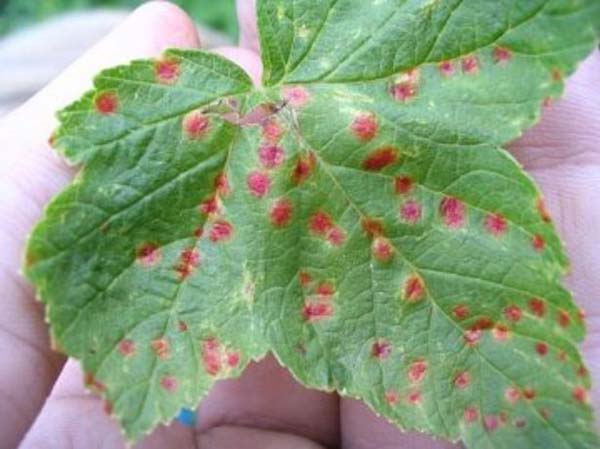
Content
Currant leaves turn red: reasons and what to do
So, red spots can form on currant leaves for two reasons:
- attack pest (leaf gall aphid or redcurrant aphid);
In this case, on the leaves appear red blistering spots in the form of blisters (a pest has started on the currant - gall aphid).Then you will need to treat the shrub with an insecticidal agent (pest drug).
- fungal disease (anthracnose).
With such a disease, the leaves appear small (like dots) brown-red spots... In this case, you need to spend spraying currants with a fungicidal preparation (means against diseases).
Next, we will consider in detail and clearly each of the causes of reddening of currant leaves.
Note! Often currant leaves blush exactly because of the attack on her by a gall aphid, anthracnose currants - this is where more rare disease.
Gall aphid (red swelling spots on red currant leaves)
If on your red currant characteristic red, blistering spots (however, these bubbles do not take on color immediately), this means that your berry bush has been attacked leaf gall aphid (Capitophorus ribis), which is also called redcurrant aphid or cystic currant aphid.
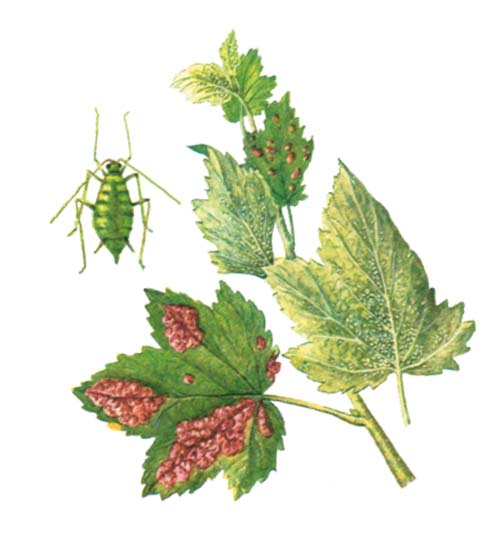
By the way! White currant - this is the same red currant (i.e. they differ only in color), therefore, it is the red currant aphid that also attacks it.
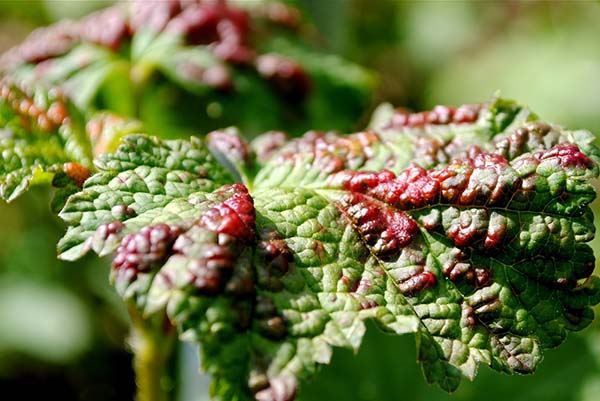
Note! Leaf gall aphids are very rare on black currant. Dit's a different matter that she is attacked much more often escaping gooseberry aphid (Aphis grossulariae), the presence of which can be determined by twisted leaves on the tops of the shoots (similar to a cocoon).
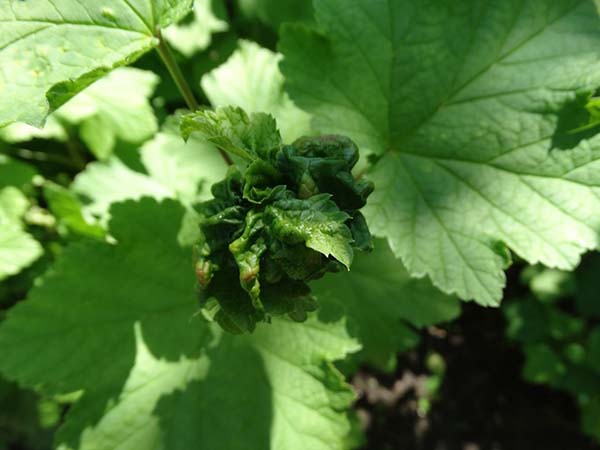
As for whether how to see the gall aphid itself on red currant leaves, then this can be done if unfolding the sheet, carefully and closely examine it back side... Of course, it is very difficult to discern it, since currant bubble aphid even smaller than melon that attacks cucumbers (less than 2 mm).
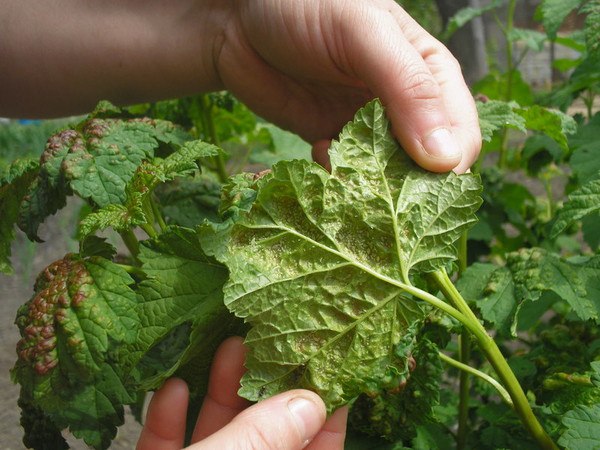
The harmfulness of the red currant aphid:
- As a result of the attack of the gall aphid on the upper (front side) of the leaves, swelling in the form of red tumors or, as it is more correct to say, Gauls.
Interesting! Gauls (or cecidia) - pathological neoplasms on the vegetative organs of plants that arise as a reaction of plants to damage by harmful organisms that feed (in this case, suck juice from the leaves) and develop inside these formations.
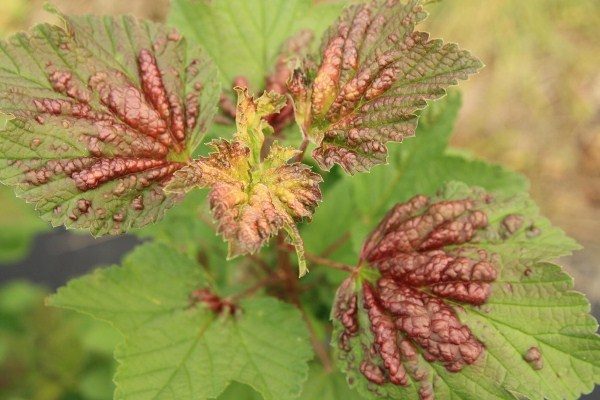
- If you do not find in time and do not take appropriate measures, then the gradual death of leaves, the plant will give a slight increase in young shoots.
By the way! The degree of damage to the leaves depends on their age. Strongest of all are affected young leaves and tops of shoots, on which a very many small red spots, and middle-aged - on them spots (swellings) noticeably larger... On adult leavesthat have finished growing, you can only notice small necrotic spots.
- As a result, naturally, significantlyyield falls, since the immune system of the entire berry bush suffers.
Methods of prevention and treatment
So, there are several basic methods of dealing with gall aphids on red currants:
- mechanical methods;
- folk remedies;
- biological insecticides (drugs);
- chemical insecticides.
By the way! The site already has a detailed article on the fight against aphids on currants.
Naturally, if you have everything several bushes or the infection is not very strong, you can try using mechanical and folk remedies:
- The easiest way - flushing aphids with a sharp stream of water from a hose on the back of the leaves (90% of the aphids fall and die).
By the way! It is believed that for fight against aphids (its eggs), wintering on the bush (in its buds), currants can be spray with boiling water in early spring.
But most often this method of processing is used against kidney mites.
- Alternatively, you can still manually remove (cut) damaged leaves and shoot tips, and then destroy them (burn).
- Use different folk (pharmacy) solutions (ammonia, soda), vegetable infusions and decoctions.
- Also, some (rather modest) efficiency is shown by planting repellent plants next to currants.
By the way! Aphids have biological enemies - ladybugs (more precisely, the seven-spotted ladybird, also called aphid ladybird), lacewings, wasps, ground beetles and even some birds (sparrows, tits, etc.).
If you don’t want to bother, and you don’t want to use chemistry, then biological preparations against pests (insecticides) come to the rescue, among which the following are used against aphids on currants (the active substance, the method of penetration, as well as the chemical class of the agent are indicated in brackets):
- Fitoverm (Aversectin C, enteric contact insecticide, class Avermectins + biological pesticides);
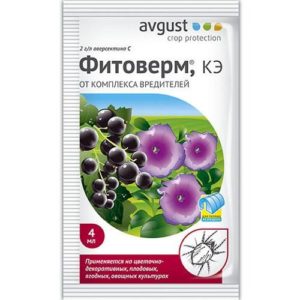
- Aktofit (Aversectin C, enteric contact insecticide, class Avermectins + biological pesticides);
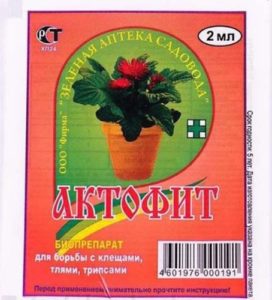
Aktofit and Fitoverm are analogues.
- Bitoxibacillin (Bacillus thuringiensis var. Thuringiensis, intestinal pesticide, bacterial insecticide + biological pesticide class);
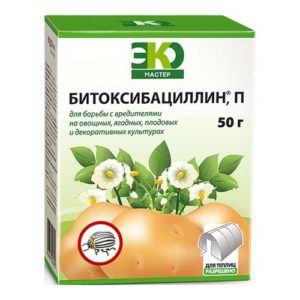
- Spark BIO (Avertin N, enteric insecticide, class Avermectins + biological pesticides);
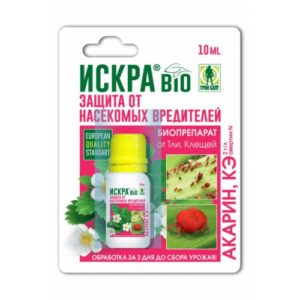
- Akarin (Avertin N, enteric contact insecticide, class Avermectins + biological pesticides);
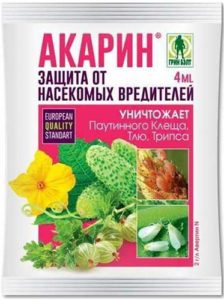
Akarin and Iskra BIO are analogues.
- Tobacco dust (Nicotine, intestinal action, class plant insecticides).
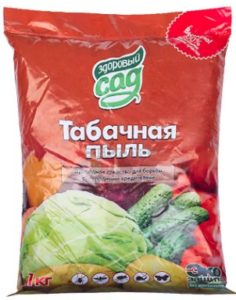
Important! The main advantages of using biological and folk remedies in the fight against aphids is that in just 1-2 days (be sure to read the instructions) after processing, you can eat currant berries.
If your currants literally exhausted by aphids, then only chemical agents (insecticides) will help you, the most popular of which are the following (the active substance, the method of penetration, and also the chemical class of the agent are indicated in brackets):
- Actellic (Pirimifos-methyl (Actellic), systemic insecticide of intestinal action + fumigant, class Organophosphorus compounds (FOS);
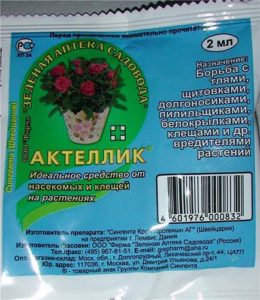
- Aktara (Thiamethoxam (Aktara), a systemic intestinal insecticide, neonicotinoid class);
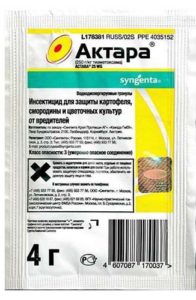
- Aliot (Malathion (Karbofos), an intestinal-contact insecticide, organophosphorus compounds (FOS) class;
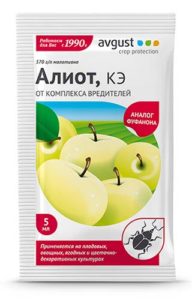
- Biotlin (Imidacloprid, systemic insecticide of intestinal action, class of neonicotinoids);
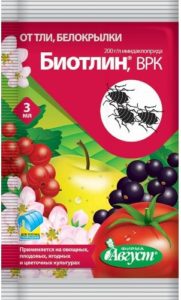
- Tanrek (Imidacloprid, systemic insecticide of intestinal action, class of neonicotinoids);
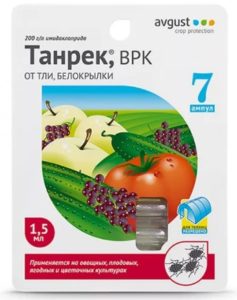
- Spark - Double effect (Permethrin and Cypermethrin, an intestinal-contact insecticide, pyrethroid class);
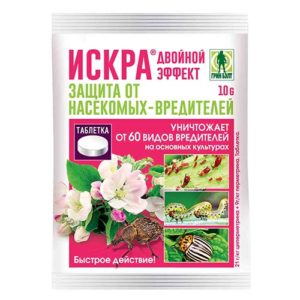
- Spark Gold (Imidacloprid, systemic insecticide of intestinal action, class of neonicotinoids);
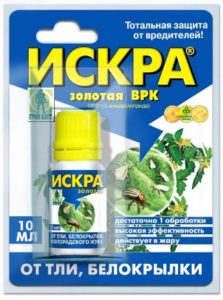
- Inta-Vir (Cypermethrin, insecticide of intestinal action, pyrethroid class);
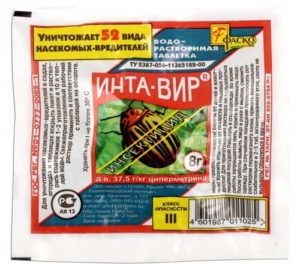
- Kinmiks (Beta-cypermethrin, an intestinal-contact insecticide, pyrethroid class);
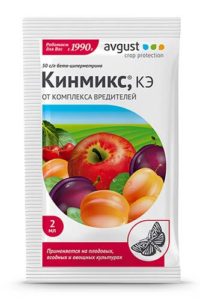
- Fufanon (Karbofos (Malathion (Karbofos)), an enteric-contact insecticide, organophosphorus compounds (FOS) class;
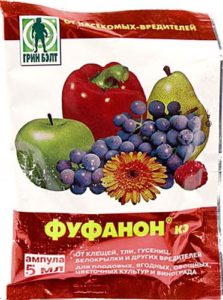
- Karbofos (Malathion (Karbofos), an enteric-contact insecticide, organophosphorus compounds (FOS) class.
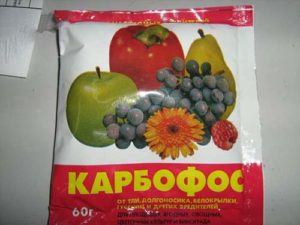
By the way! From wintering stages of pests (to kill aphids in the embryo, more precisely, its eggs) the drug has proven itself well 30 Plus (Vaseline oil, contact action, mineral oil class) and Prophylactin (Vaseline oil and Malathion (Karbofos), enteric-contact action, mineral oils + organophosphorus compounds (FOS) class.
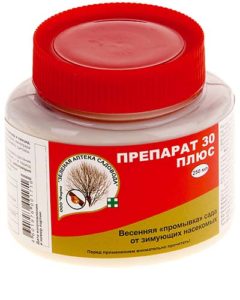
The first spraying with insecticide is recommended still early spring, before buds bloom.
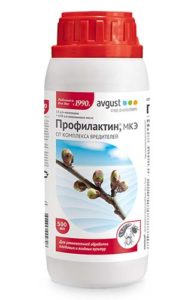
Important! Aphids are one of those pests that are almost impossible to defeat completely, they will constantly infect your berry bushes.
Therefore, some gardeners believe that if you often use chemicals, it is unlikely that this will have a good effect on your plants and the usefulness of their fruits.
However, it should still be borne in mind that at the end of the waiting period, the drug completely dissolves and evaporates, in other words, chemical agents do not accumulate in plants.
Anthracnose (red dotted spots on currant leaves)
Currant anthracnose is a fungal disease that causes the marsupial mushroom Pseudopeziza ribis Kleb.
Interesting!
- Pathogens hibernate in the form of mycelium on fallen leaves.
- In the spring they spread along with raindrops and various insects.
- Accordingly, regions with sufficient moisture (ideal humidity - about 90%) and moderate temperatures (over +22 degrees) are especially susceptible to the disease.
The main sign of anthracnose currant disease is the formation on the leaves small round spots of dark brown (red) color, on which then shiny black tubercles appear (conidial sporulation of the fungus). And with a strong development of the disease spots merge, leaves turn brown, dry up, their plates are curled upside down. They are premature fall off and remain only at the ends of growing shoots.
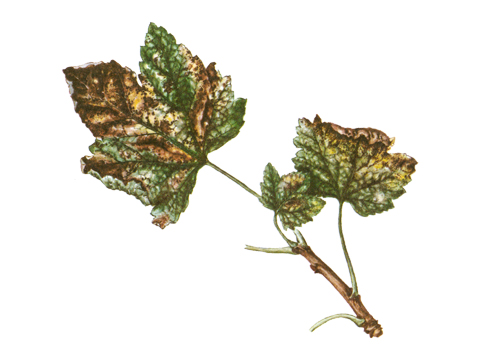
Also, the disease affects leaf stalks, green shoots and stalks, black, slightly depressed spots with weak sporulation are formed on them.
Moreover, on berries you can also see small light brown specks with a red border.
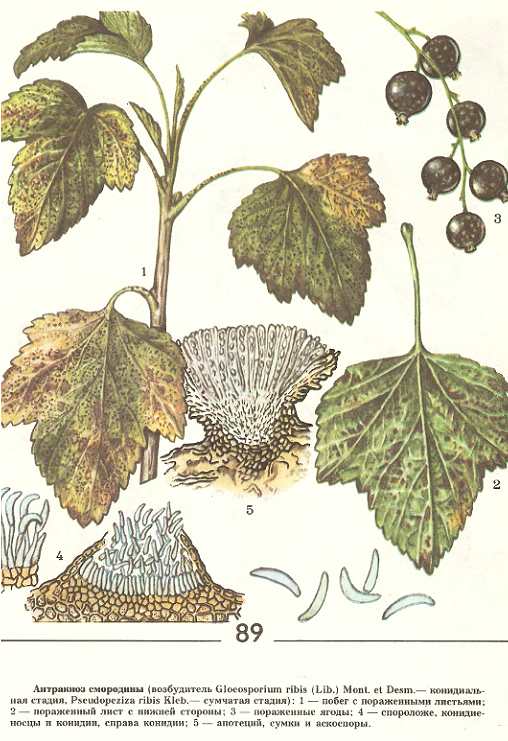
As a result, the strong development of the disease leads to premature death of the affected leaves, exposure of bushes and death of young shoots.
Thus, currant anthracnose is a very harmful disease, in which, in the event of a severe damage to the bushes, the currant yield decreases to 75% this year and to 80% in the following. Also, the disease adversely affects the frost resistance of the shrub, due to which more than half of the vegetative part (branches) can die off (freeze out).
Important! Do not confuse anthracnose with septoria (white spotted) currants! In this case, brown spots appear on the leaves, which eventually brighten in the center, and turn brown at the edges.
However, drugs against anthracnose and currant septoria - the same.
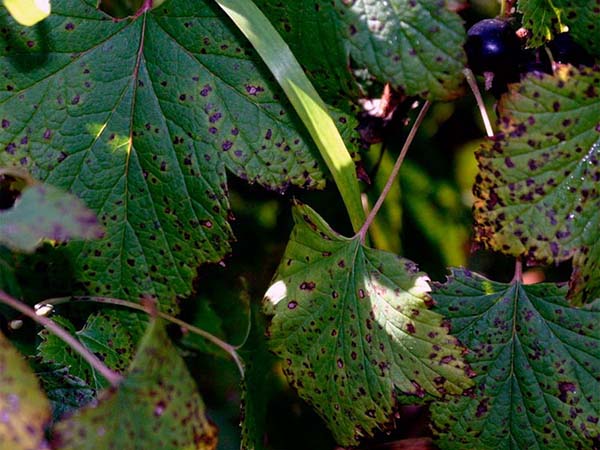
Methods of prevention and treatment
Exists agrotechnical methods of prevention currants from anthracnose, namely:
- autumn collection and destruction of fallen leaves (so that pathogens cannot overwinter near the bushes);
- cultivation of resistant varieties.
If small red spots have already appeared on the leaves of your currant, then to treat the infected shrub it must be treated with chemical fungicides (biofungicides do not show sufficient effectiveness against anthracnose).
Advice! And even better, if you carry out timely preventive (protective) spraying, without waiting for the development of the disease.
As a rule, the following fungicides are used for spraying currant bushes from anthracnose (agents against diseases, most often based on copper, inorganic substances, dithiocarbamates and triazoles):
The active substance, the method of penetration and action, and the chemical class are given in brackets.
- Bordeaux mixture (copper sulfate and calcium hydroxide, contact fungicide of protective action, class - inorganic substances + copper compounds);
By the way! The site already has a detailed article about the preparation and use of Bordeaux liquid.
As a rule, early spring spraying in the "green cone" phase is carried out with a 2.5-3% solution; during the growing season, the first spraying is carried out after flowering, the subsequent (recommended 2) - with an interval of 7 days, 1% solution.
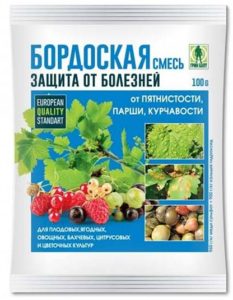
Some, mostly old, sources indicate that pure copper sulfate and the drug Hom.
- Tsikhom (Copper oxychloride and Tsineb, contact-systemic fungicide of protective action, class - Dithiocarbamates + inorganic substances + copper compounds);
- Propi Plus (Propiconazole, systemic fungicide of protective and curative action, class - Triazoles);
- Titan (Propiconazole, systemic fungicide of protective and curative action, class - Triazoles);
- Agrolekar (Propiconazole, systemic fungicide of protective and curative action, class - Triazoles);
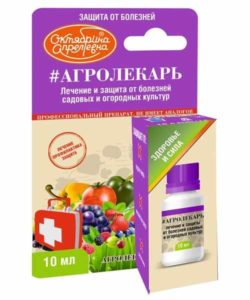
- Chistoflor (Propiconazole, systemic fungicide of protective and curative action, class - Triazoles);
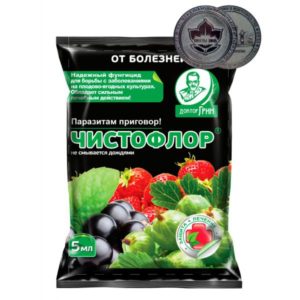
- Prognosis (Propiconazole, systemic fungicide of protective and curative action, class - Triazoles);
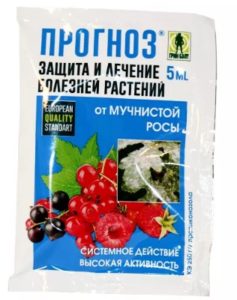
- Tilt (Propiconazole, systemic fungicide of protective and curative action, class - Triazoles).
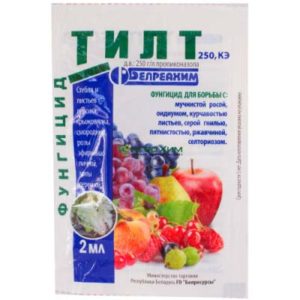
Sometimes on sale you can Tilt-250 (250 g / l is the concentration of the active ingredient - Propiconazole.
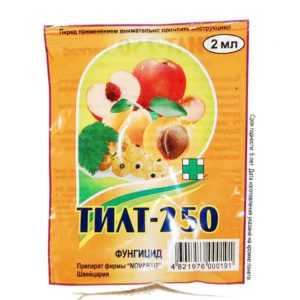
By the way! As you understand, the last 4 drugs are all analogues that have the same active ingredient - Propiconazole.
Thus, now you know what to do if the leaves of the currant began to turn red, or rather, red-brown spots appeared on them in the form of dots or bulges. Well, good luck with your pest and disease control. But don't forget about prevention!
Video: what to do if red spots appear on currant leaves


Hello! Well, finally, I found the name of this disease in my currant, and what are these red dots. Thank you for such a detailed description and pictures, they helped me a lot to understand. Although, I am not a supporter of chemistry in the garden, but sometimes it is impossible to cope with pests without it. And what do you think?
If without fanaticism, observing all recommendations for concentration and waiting times, then there is nothing wrong with chemistry. Of course, if possible, it is better to use biological preparations, but, unfortunately, they cannot always help, but it is necessary to act.